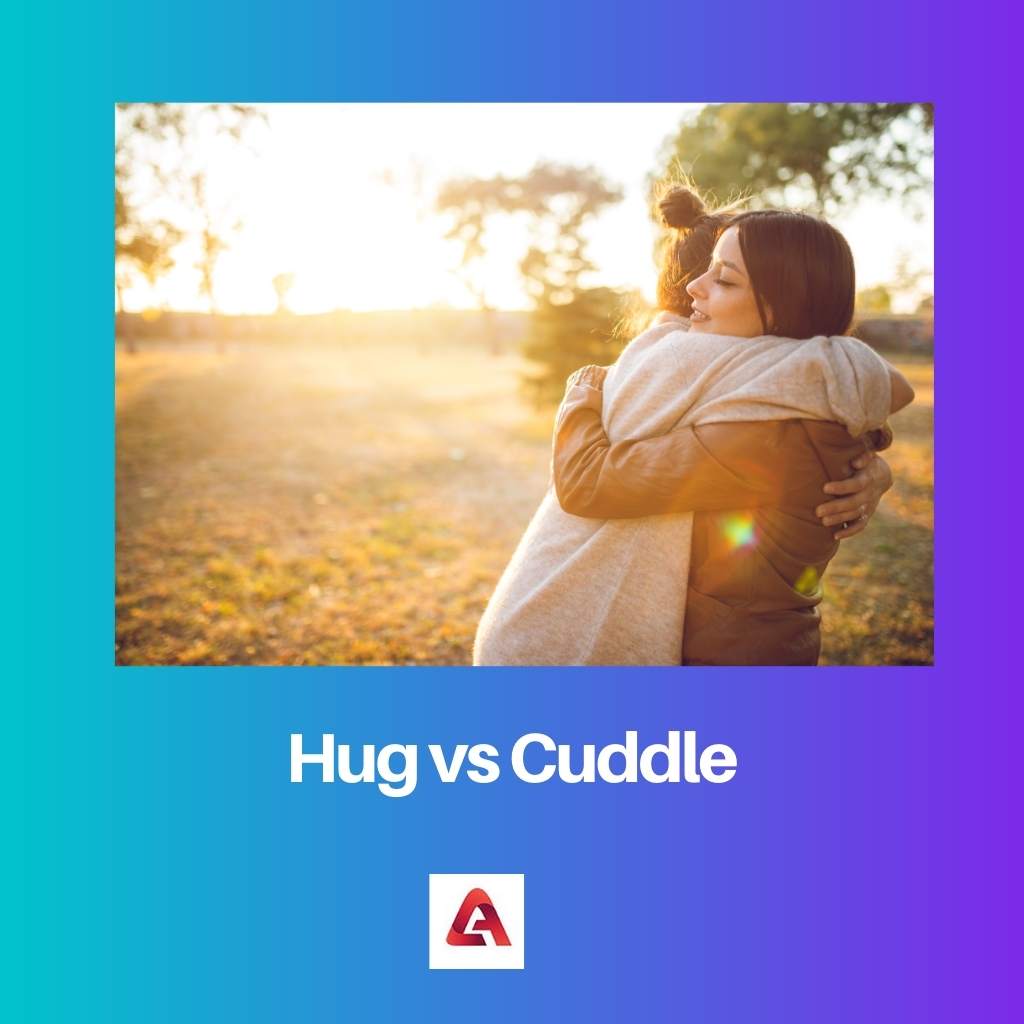Human beings are considered social animals. They stick around their close ones, make love to them, make them feel special, share happiness, support them, and stand in times of sorrow and pain.
Generally, communication between two individuals does not require many words to explain but some cute expressions, such as hugging and cuddling.
Many people think that both non-verbal communication, hugging and cuddling, are the same. But no, they have certain key differences between them as well.
Key Takeaways
- Hugging involves wrapping your arms around someone in an embrace, while cuddling involves holding someone close to your body while lying down or sitting.
- Hugging is a brief gesture of affection, while cuddling is a prolonged and intimate form of physical contact.
- Hugging can be done while standing, while cuddling requires comfortable seating or lying.
Hug vs Cuddle
The difference between a hug and a cuddle is that a hug is a mutual form of embrace between two people, which can be done as a greeting, love, and affection both personally and professionally. However, in the case of cuddling, it can be mutual or even can one-sided, where one person gives love and affection to the other person who receives it. A hug can occur between any two individuals. However, cuddling occurs between couples and close people.

Love, brotherhood, sisterhood, friendship, warmth and affection can be expressed while hugging. This act can offer comfort, support and sympathy between each other. While greeting, two individuals can hug each other and hence greet each other.
When two individuals want to hug, they both hug by in a position of standing. The level of intimacy in case the of a hug is not as high and intense as it is in the case of a cuddle. The act refers to a brief embrace between two people or can be done for a longer time between a couple.
Cuddling, the act of wrapping around each other’s body, is mainly associated with affection and love. This act does not indicate the act of support, comfort or sympathy. The act of greeting can not be done by cuddling.
Two close individuals must sit together intimately or lie close to cuddle. This is more intimate, affectionate and even intense than the act of hugging. It refers to a long embrace between two close individuals.
Comparison Table
| Parameters of Comparison | Hug | Cuddle |
|---|---|---|
| Type of embrace | Brief embrace | Long embrace |
| Level of Intimacy | A hug is not intense. | Cuddle is more intense, intimate and affectionate. |
| Position | It can be done only while standing. | It can be done either by lying down or sitting together. |
| Expression | Love, warmth, brotherhood, sisterhood, friendship, affection can be expressed. | Mainly associated with affection and love, only. |
| Form of Greeting | Hug involves the act of greeting. | Cuddling does not involve the act of greeting. |
| Sympathy and Support | Offers comfort, support or even sympathy. | Does not offer comfort, support or sympathy. |
What is Hug?
A hug is a type of nonverbal communication that involves physical intimacy. When two people put their arms on the other person’s back, neck or waist, it is referred to as hugging.
Hug indicates familiarity, affection, love, friendship, brotherhood and sisterhood. However, hugging also indicates comfort, solidarity and even sometimes support.
It is sometimes done as an act of showing sympathy or congratulations. Some cultures include hugging as a common practice while greeting as well. But this kind of hug does not indicate affection or love. It is purely professional.
When the number of people involved is more than two while hugging, it is known as a group hug.
Hugging is done in the standing position. This act is normal for people of all age groups sharing various kinds of relationships. A mother can hug her kid, daughter, and son; two siblings can hug each other.
A grandmother can hug her grandchildren; a boyfriend can hug her girlfriend; a husband can hug her wife, children and thus so on.
However, hugs between a couple indicate love, lust, romance and sexual feelings. It can also be done as an act of acceptance as well.

What is Cuddle?
Cuddling is physical intimacy involving two people very closely wrapped around each other’s arms and bodies. Cuddling occurs between lovers and indicates a more intimate and affectionate bonding than hugging.
However, it is also associated with family members as well. Cuddling is done for a much longer period.
When two people sit together or lie down intimately, then cuddling occurs. Unlike again, cuddling cannot be found as an act of greeting or congratulation. It occurs only when two people share a very close relationship, such as a couple and a mother and her children.
Cuddling is an indication of love, trust, similarity and belief.
Cuddling is not acceptable in any public place, as it is considered taboo, and the people doing it in the public area are considered criminals. When a mother takes care of her baby, the child, for a long time till the baby falls asleep, it can be considered as cuddling between them.
Generally, when two people love or like each other immensely, they cuddle is an indication of romance, affection and love.

Main Differences Between Hug and Cuddle
- Love, warmth, brotherhood, sisterhood, friendship, and affection can be expressed via hugs. In contrast, a cuddle is mainly associated with affection and love only.
- A hug can offer comfort, support or even sympathy. In contrast, cuddling does not indicate an act of comfort, support or sympathy.
- While greeting, two people can hug each other. However, greeting can not be done by cuddling.
- When two people want to hug, they need to be in a standing position. However, when two people lie down or sit together, cuddling occurs.
- The level of intimacy in a hug is not as intense as it is in the case of a cuddle. Cuddle is more affectionate, intimate and even intense.
- Hug refers to a brief embrace. On the other hand, a cuddle refers to a long embrace.


This discussion of hugging and cuddling provides an illuminating examination of the differences in their emotional connotations and social contexts, enriching our understanding of non-verbal communication.
I agree. The discerning analysis of hugging and cuddling contributes to a more comprehensive grasp of the multifaceted meanings and functions of these physical expressions.
This piece offers valuable insights into the meanings and implications of hugging and cuddling, clarifying their unique roles in expressing love and affection.
I appreciate the attention to detail and clarity in distinguishing the intended sentiments and contexts of hugging and cuddling.
The article’s inclusive discussion helps to dispel misconceptions and deepen our understanding of the emotional and interpersonal dimensions of hugging and cuddling.
The precise differentiation of hugging and cuddling in this article is enlightening, shedding light on the varying degrees of intimacy and emotional expression associated with each act.
Indeed, the article effectively demonstrates the nuanced nature of hugging and cuddling, highlighting their distinct forms of affection and intimacy.
I agree. The comparison table serves as a useful summary of the key differences and characteristics of hugging and cuddling.
The nuanced analysis of hugging and cuddling in this article contributes to a deeper understanding of the distinct expressions of warmth, affection, and support between individuals.
The clear differentiation and descriptive examples offered in the comparison between hugging and cuddling enhance our comprehension of these physical acts as means of connection and expression.
I agree. The scrutiny of the roles and contexts in which hugging and cuddling are employed enriches our comprehension of their unique communicative aspects.
The insightful exploration of hugging and cuddling elucidates the varied emotional resonances and relational dynamics inherent in these non-verbal forms of affection and support.
The article’s meticulous elaboration of the intricate nuances of hugging and cuddling enhances our awareness of the diverse communicative and interpersonal aspects of these physical gestures.
The thorough analysis of hugging and cuddling deepens our understanding of the profound emotional and social dimensions encompassed by these intimate acts of non-verbal communication.
This article provides a nuanced understanding of the different forms of physical connection and their emotional underpinnings, enhancing our appreciation of hugging and cuddling.
The author’s comprehensive analysis of hugging and cuddling serves as a valuable resource, deepening our insight into these non-verbal modes of emotional expression.
The article offers a comprehensive examination of both hugging and cuddling, effectively highlighting their unique characteristics and significance within different relationships.
I find the emphasis on the emotional and situational implications of hugging and cuddling to be illuminating and thought-provoking.
The in-depth examination of hugging and cuddling in this article helps to demystify the nuanced differences between these physical expressions of intimacy and affection.
This piece effectively captures the intricacies of hugging and cuddling, highlighting the diverse emotional and relational meanings associated with each gesture.
The article offers an insightful exploration of the complex emotional and social dimensions inherent in hugging and cuddling, elaborating on their unique roles within human relationships.
This article provides a thorough comparison between hugging and cuddling, showing a keen understanding of the differences between the two physical expressions of intimacy.
I appreciate the comprehensive coverage and distinction of these two fundamental forms of physical intimacy.
The detailed comparison of hugging and cuddling in this article offers a comprehensive understanding of the emotional and relational contexts in which these physical acts are situated.
I appreciate the precision and thoroughness in the delineation of the similarities and distinctions between hugging and cuddling, shedding light on their respective communicative nuances.